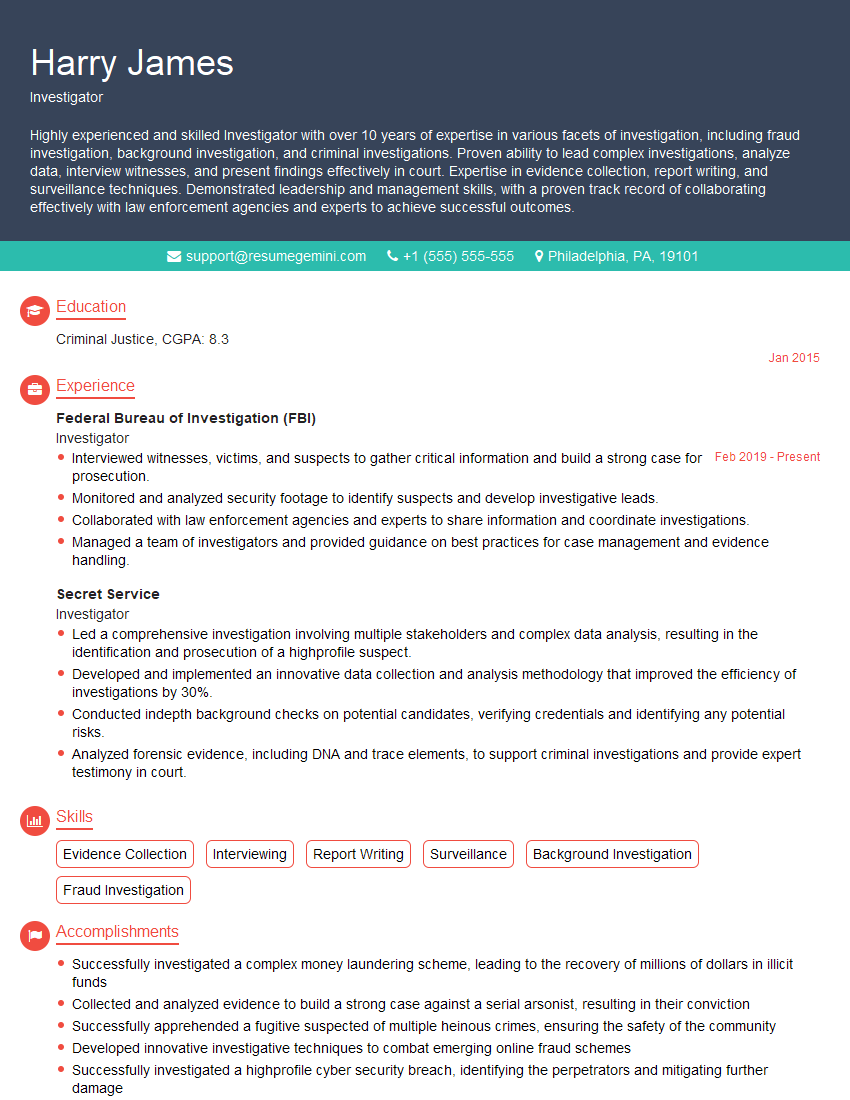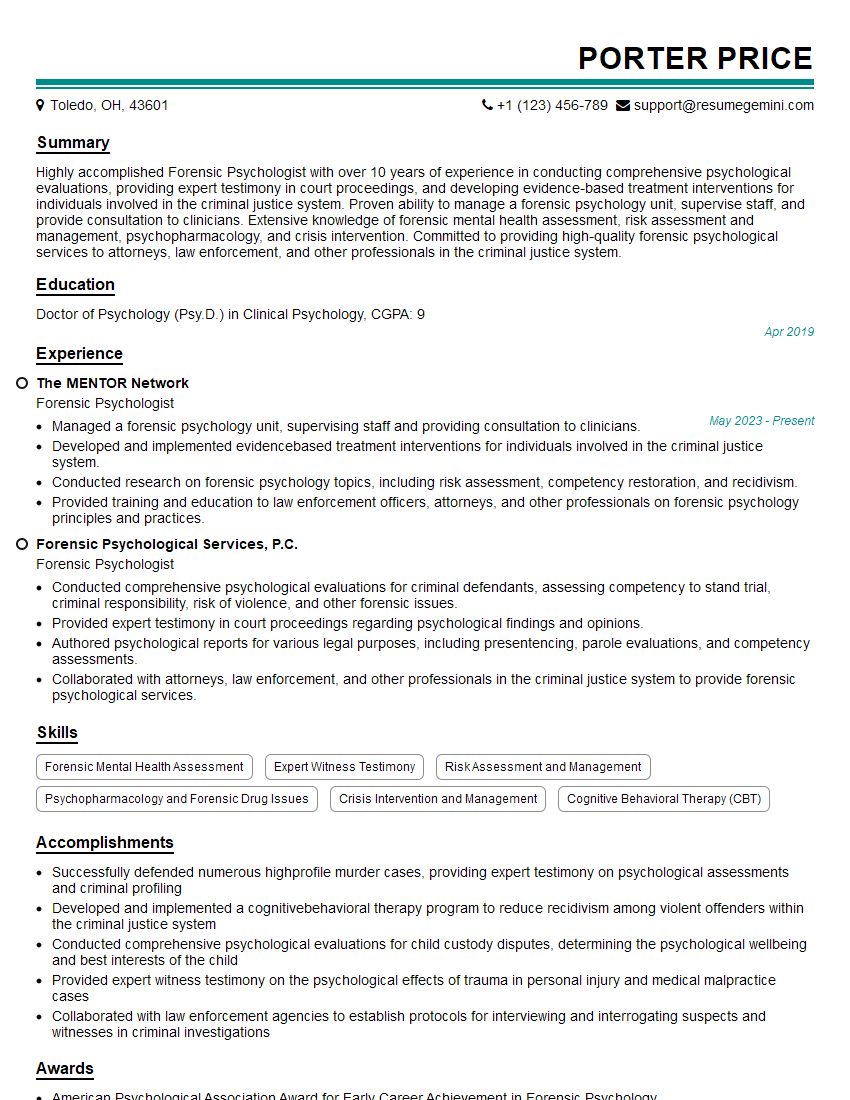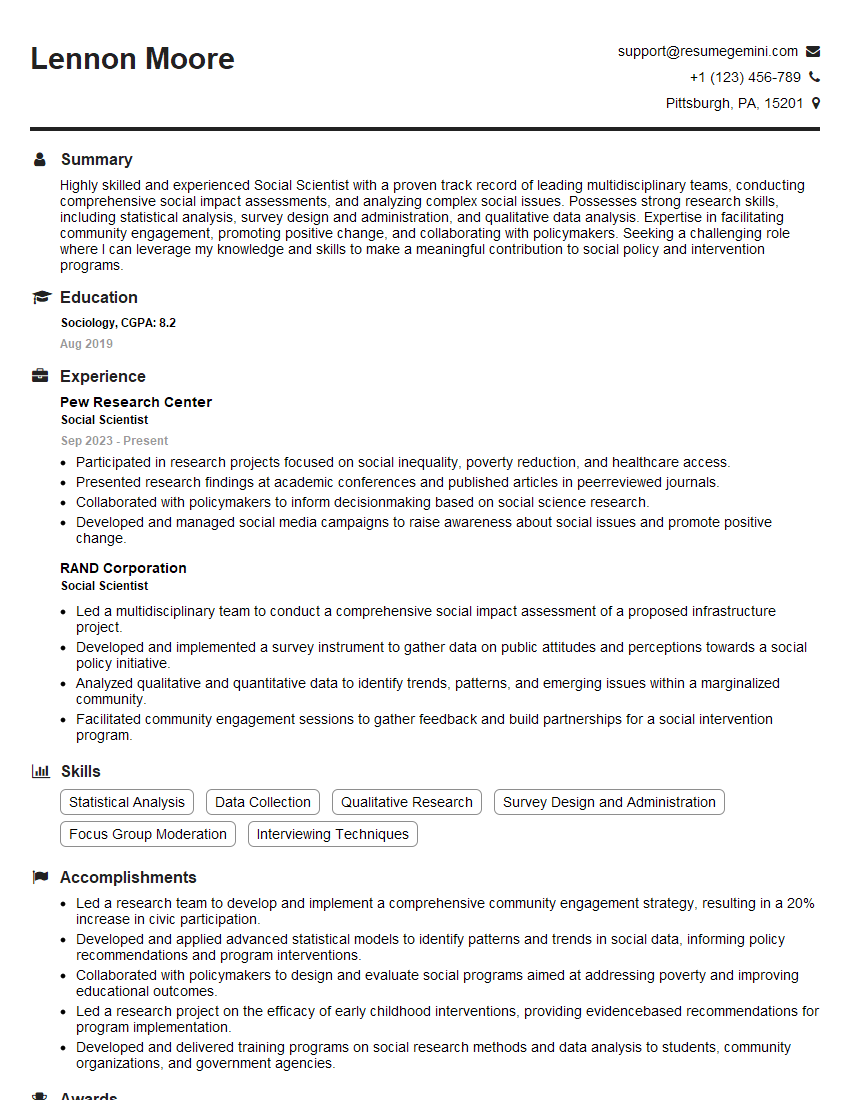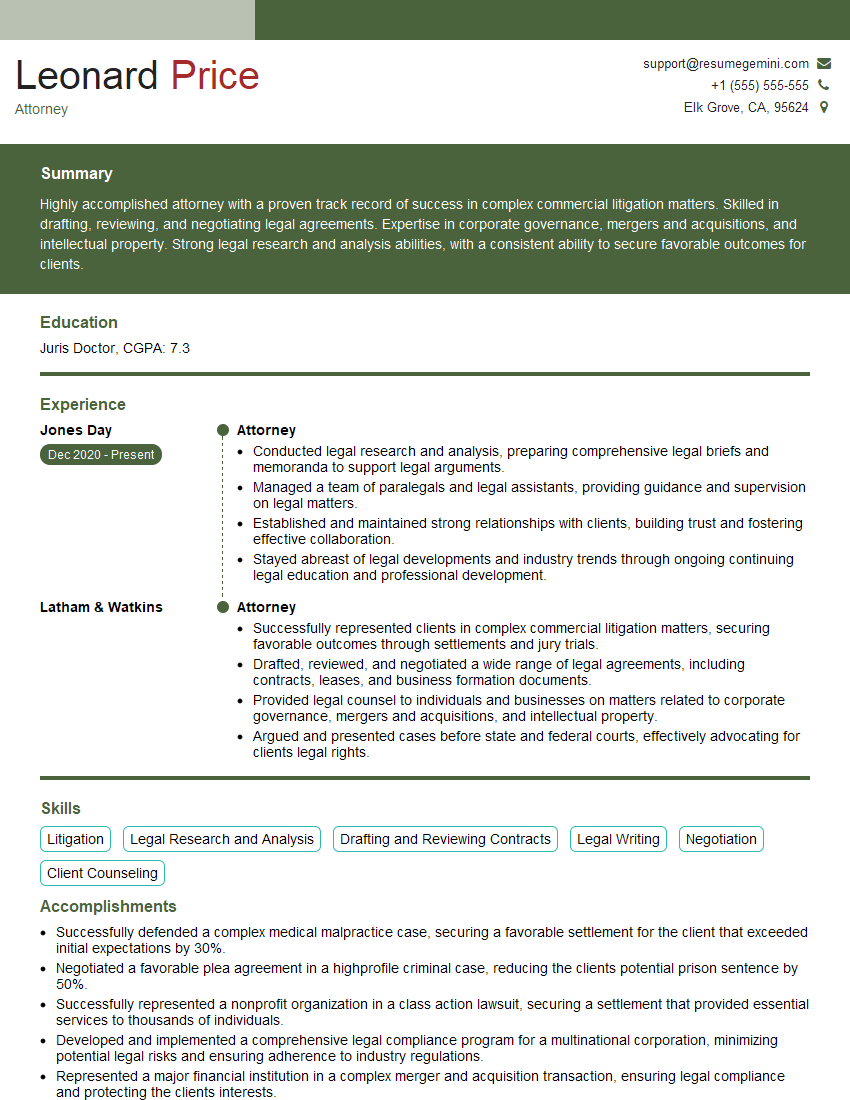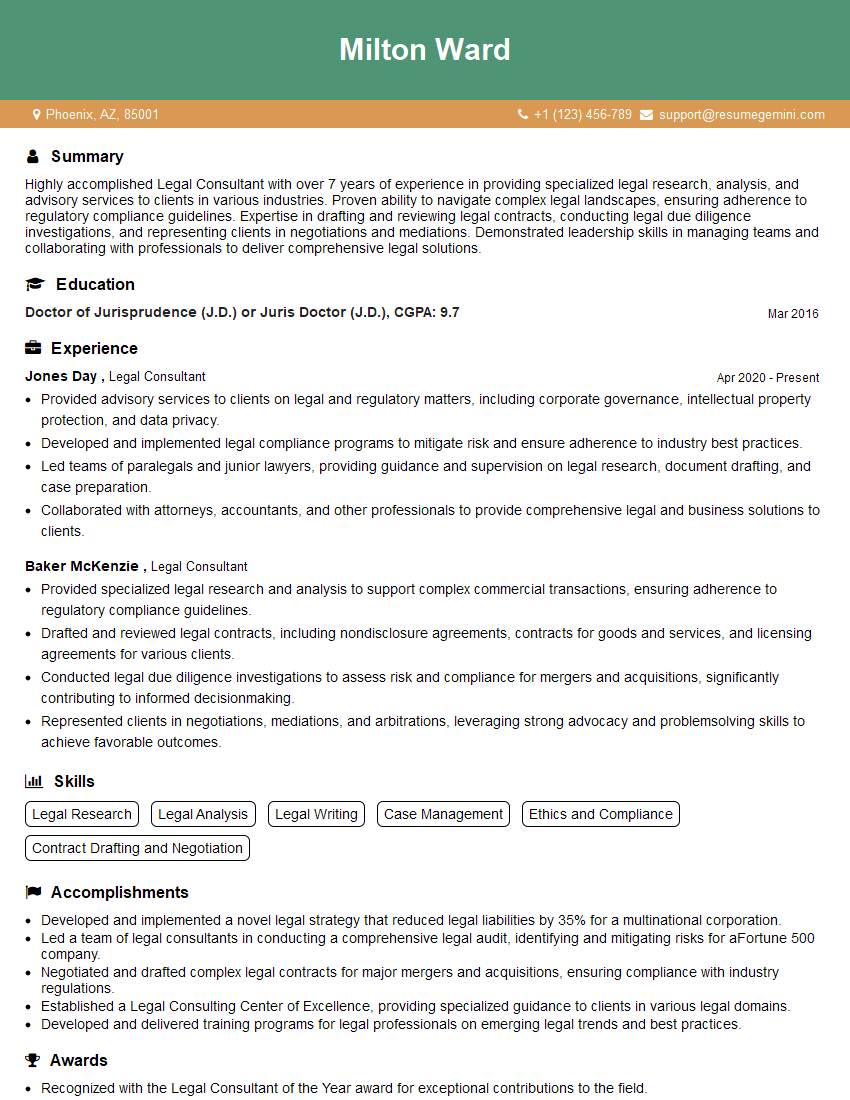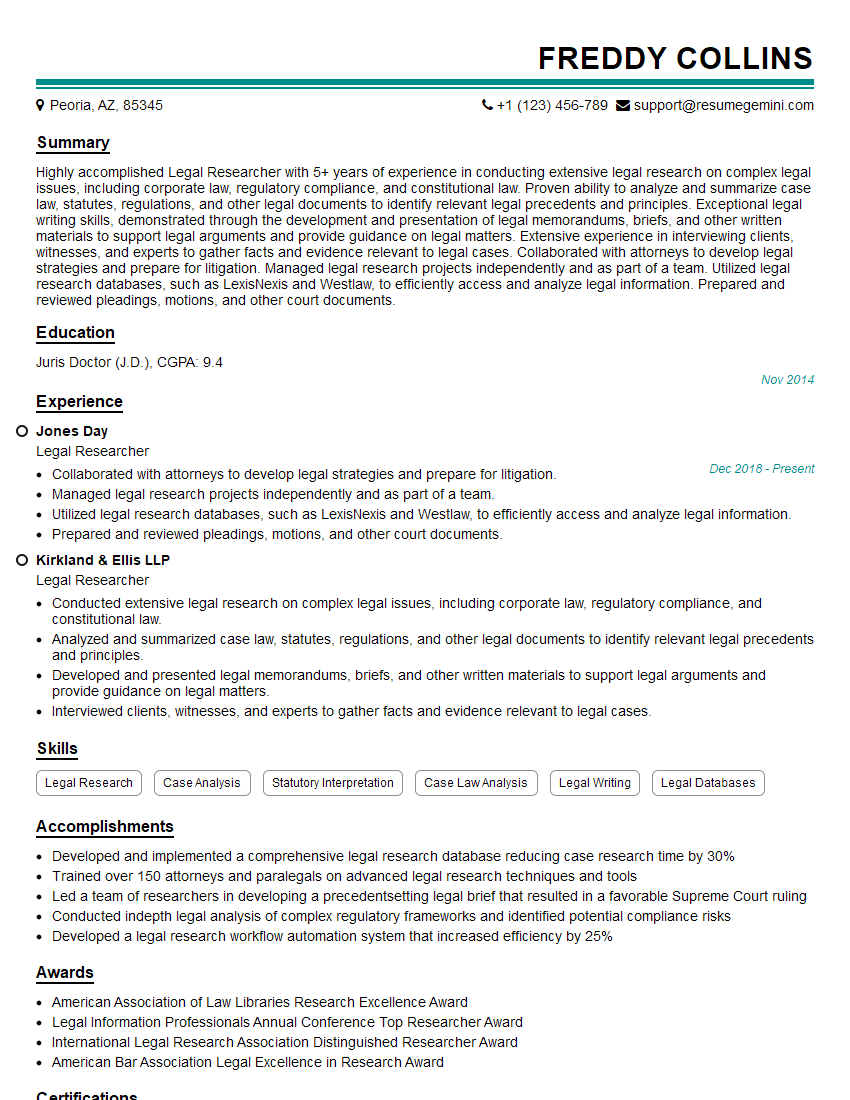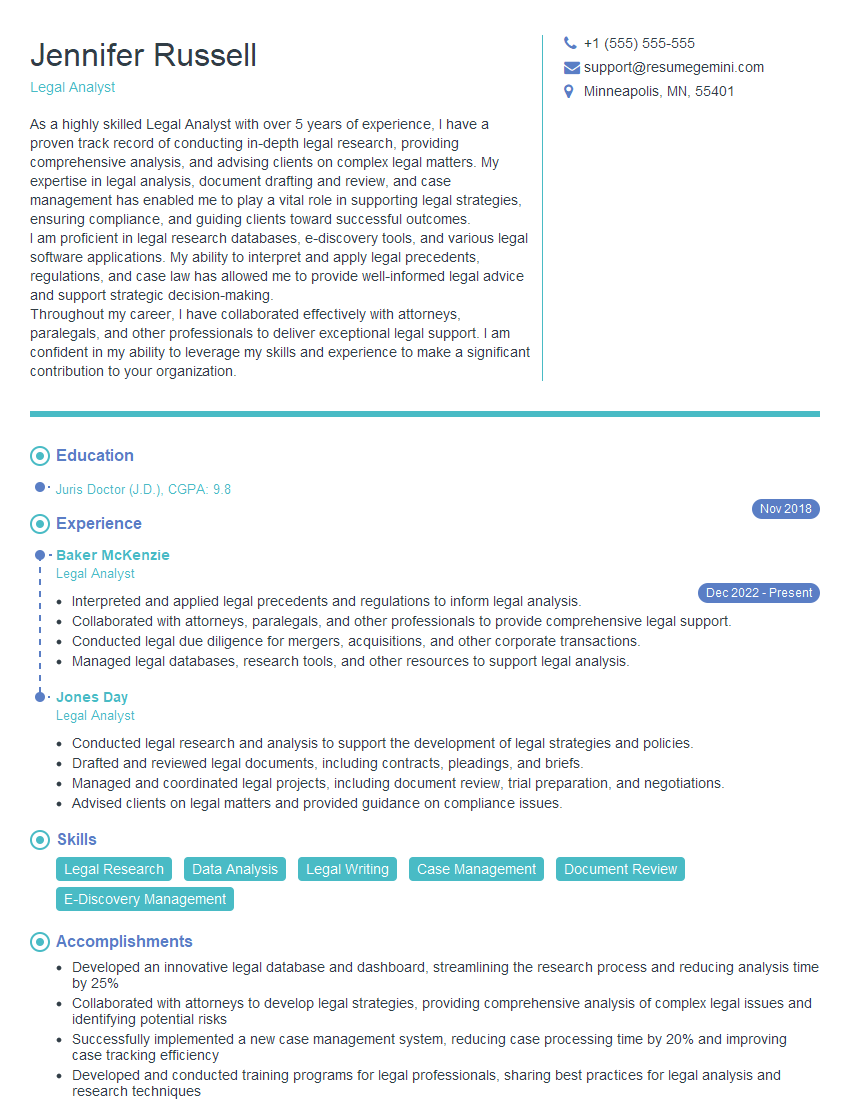Warning: search_filter(): Argument #2 ($wp_query) must be passed by reference, value given in /home/u951807797/domains/techskills.interviewgemini.com/public_html/wp-includes/class-wp-hook.php on line 324
Interviews are more than just a Q&A session—they’re a chance to prove your worth. This blog dives into essential Voir Dire and Jury Selection interview questions and expert tips to help you align your answers with what hiring managers are looking for. Start preparing to shine!
Questions Asked in Voir Dire and Jury Selection Interview
Q 1. Describe the process of conducting Voir Dire.
Voir Dire, meaning “to speak the truth” in French, is the process of questioning potential jurors to determine their suitability for a particular case. It’s a crucial stage in the trial process, allowing attorneys to identify and remove biased or otherwise unsuitable jurors. The process typically begins with the judge introducing the case and the attorneys. Then, potential jurors are questioned individually or in panels, depending on the court’s procedures and the judge’s preference. Questions are designed to uncover potential biases, prejudices, or experiences that might influence their impartiality. This may involve exploring their knowledge of the case, their opinions on relevant issues (e.g., law enforcement, self-defense), or their personal relationships that could create conflicts of interest. The goal is to assemble a jury that is fair and impartial, capable of rendering a just verdict based solely on the evidence presented in court.
Imagine a case involving a corporate executive accused of fraud. During Voir Dire, attorneys would diligently seek out jurors with potential biases related to corporate behavior, wealth, or even the specific industry involved. They might ask questions probing the jurors’ trust in large corporations, their feelings about financial crimes, or their personal experiences with similar situations to ensure the jury reflects a diverse range of perspectives unclouded by preconceived notions.
Q 2. Explain the difference between challenges for cause and peremptory challenges.
Challenges for cause and peremptory challenges are two distinct methods used to remove potential jurors. A challenge for cause is based on a specific reason or bias demonstrated by the potential juror that shows they cannot be impartial. This could be prior knowledge of the case, a relationship with one of the parties, or expressed prejudice against a specific group. To successfully challenge for cause, the attorney must persuade the judge that the juror’s impartiality is genuinely compromised. In contrast, a peremptory challenge allows an attorney to remove a juror without stating a specific reason. The number of peremptory challenges allowed is typically limited and varies by jurisdiction and the type of case. While peremptory challenges cannot be used to remove jurors based on race or gender (as per Batson v. Kentucky), they provide flexibility in shaping the jury pool.
Think of it this way: a challenge for cause is like presenting evidence of a juror’s unsuitability to a judge, while a peremptory challenge is like exercising a strategic veto.
Q 3. How do you identify potential juror biases during Voir Dire?
Identifying potential juror biases during Voir Dire requires careful listening and strategic questioning. Attorneys employ several techniques to uncover biases. One method is asking direct questions about the potential juror’s opinions on relevant issues, but this can be risky, as a direct question might elicit a response that isn’t entirely truthful. Therefore, indirect questioning is often preferred. It involves using hypotheticals or scenarios related to the case facts to gauge potential jurors’ attitudes and beliefs without directly asking for their opinion on the case itself. Furthermore, analyzing the juror’s nonverbal cues—body language, facial expressions, and tone of voice—can also provide valuable insights into their true feelings. Finally, reviewing juror questionnaires, when permitted, can provide additional information.
For example, in a medical malpractice case, an attorney might not directly ask, “Do you distrust doctors?” Instead, they could present a hypothetical scenario involving a medical error and gauge the potential juror’s reaction. Similarly, body language indicators like avoiding eye contact or displaying discomfort when discussing the subject of medical errors could further indicate a bias.
Q 4. What are some effective techniques for questioning potential jurors?
Effective questioning during Voir Dire involves a combination of open-ended questions, hypothetical scenarios, and targeted follow-up questions. Open-ended questions encourage detailed responses and reveal more than simple ‘yes’ or ‘no’ answers. Hypothetical scenarios allow attorneys to explore how potential jurors might react to specific evidence or situations. Follow-up questions are crucial to clarify ambiguous answers or probe for deeper insights. It is vital to listen attentively and adjust questions based on the jurors’ responses. Attorneys must also be mindful of the judge’s rulings and avoid asking inappropriate or leading questions.
Instead of asking, “Do you believe the defendant is guilty?” (inappropriate), a better approach would be: “Imagine you heard evidence suggesting the defendant acted carelessly. How might that influence your view of the case?” The latter approach prompts a more thoughtful and revealing response.
Q 5. How do you analyze juror questionnaires and responses?
Juror questionnaires are valuable tools for pre-screening potential jurors. Analysis of these questionnaires involves identifying potential biases, conflicts of interest, or experiences relevant to the case. This can be done by looking for specific keywords, patterns, or inconsistencies in the responses. It’s important to consider the context of each answer, looking for nuanced clues that might indicate bias. For example, a seemingly neutral answer may, when considered alongside other answers, reveal underlying prejudices.
Suppose a questionnaire asks about experiences with law enforcement. A juror might answer “no prior negative experience” but may also express strong views against police brutality in another section of the questionnaire. This discrepancy suggests a potential bias that needs further investigation during Voir Dire.
Q 6. Explain the importance of nonverbal communication in Voir Dire.
Nonverbal communication is incredibly important during Voir Dire. It often reveals more than words alone. Attorneys should pay close attention to body language, such as eye contact, facial expressions (e.g., smirks, frowns, raised eyebrows), posture, and fidgeting. These cues can indicate discomfort, agreement, or disagreement with certain topics or questions, revealing hidden biases or preconceived notions. For example, consistent eye avoidance or frequent shifting in the chair could indicate discomfort or nervousness regarding certain aspects of the case. Experienced attorneys will carefully note these nonverbal signals, adapting their questioning strategy to further explore potential biases.
Imagine a juror repeatedly avoids eye contact when asked about their views on the death penalty in a capital case. This might indicate a strong aversion to the death penalty, even if verbally the juror claims to be open-minded. Observing and interpreting this nonverbal cue is critical.
Q 7. How do you adapt your Voir Dire strategy based on the specific case facts?
Adapting Voir Dire strategy to specific case facts is crucial for effective jury selection. The specific issues, claims, and evidence in a case will influence the type of questions asked and the biases to be investigated. A case involving complex financial transactions will require different questions and a different focus than a case involving a domestic dispute. In a product liability case, for example, the questions would focus on the jurors’ experiences with similar products, their attitudes towards corporate responsibility, and their understanding of the legal concepts involved. The attorney would need to investigate biases related to the specific product and the industry it’s associated with. In contrast, a personal injury case might focus on questions surrounding pain and suffering, insurance claims, and perceptions of medical professionals.
For example, in a case involving a dog bite, questions would focus on experiences with dogs, personal views on animal ownership, and the extent to which a potential juror empathizes with the injured party or the dog owner. The attorneys would aim to identify jurors who might be more sympathetic to either side based on their personal experiences and beliefs.
Q 8. Describe your experience using technology to aid in jury selection.
Technology significantly enhances jury selection. I utilize jury data analytics platforms that provide demographic, social media, and public records information on potential jurors. This allows for a more informed approach to questioning during voir dire. For instance, a platform might reveal a potential juror’s involvement in community organizations, which could indicate their values and potential biases. I also employ software to manage and track juror responses, ensuring consistent record-keeping and facilitating efficient analysis of potential juror tendencies. This allows me to identify patterns and make strategic decisions about challenges. Finally, I often use presentation software to visually represent data and key information during the selection process, making complex details more accessible to my team and the court.
For example, in a recent medical malpractice case, analyzing social media activity of potential jurors revealed several who had expressed strong opinions on the healthcare system. This data allowed us to carefully tailor our voir dire questions to assess their biases in a more targeted way.
Q 9. How do you handle difficult or unresponsive potential jurors?
Handling unresponsive or difficult potential jurors requires patience, tact, and strategic questioning. It’s crucial to understand the reason for their unresponsiveness – it might be shyness, distrust, or a deliberate attempt to avoid revealing potentially prejudicial information. I start by building rapport using non-threatening questions about their background or experiences unrelated to the case. If the unresponsiveness persists, I attempt to rephrase my questions more clearly and simply. Sometimes, a gentle reminder of their civic duty and the importance of honesty in the process can be helpful. In extreme cases of deliberate unresponsiveness or evasion, I may flag them for a potential challenge for cause, explaining to the judge why they are unable or unwilling to provide adequate information.
In one case, a potential juror initially appeared evasive during questioning about their views on police brutality. Instead of pressing aggressively, I shifted focus to their understanding of the judicial process, fostering trust through neutral conversation. Eventually, they felt more comfortable and offered relevant details about their perspective.
Q 10. What are some common mistakes to avoid during Voir Dire?
Common mistakes during voir dire include asking leading questions, revealing your case strategy too early, alienating potential jurors with aggressive questioning, and failing to properly document responses. Leading questions bias the answers you receive and can undermine your credibility with the judge. Prematurely revealing your case strategy can give opposing counsel an advantage. Aggressive questioning can create animosity and make it harder to gauge true opinions. Failing to adequately document responses makes it difficult to justify challenges for cause. A thorough strategy is vital and must be tailored to the specifics of each case.
- Avoid leading questions: Instead of asking, “Don’t you agree that speeding is dangerous?” ask, “What are your thoughts on speeding and its potential consequences?”
- Avoid revealing your strategy: Focus on understanding their perspectives rather than positioning them in favor of your client’s argument.
- Maintain professional decorum: Treat every potential juror with respect, even if you disagree with their responses.
- Meticulous documentation: Maintain clear, detailed records of responses for each potential juror.
Q 11. How do you assess the credibility of potential jurors?
Assessing juror credibility involves attentive listening and observation beyond simply their verbal responses. I look for consistency in their answers across various lines of questioning. Nonverbal cues such as body language, eye contact, and tone of voice can be revealing. Inconsistencies or evasiveness raise flags. Prior work experience, community involvement, and personal background offer insight into potential biases and commitment to truthfulness. I always strive to look for discrepancies between what they say and how they say it.
For example, a potential juror might verbally state their impartiality, but their body language might indicate discomfort or nervousness when certain topics are discussed – that would warrant further questioning. A thorough review of their background information, if available, can add another layer of insight.
Q 12. How do you build rapport with potential jurors?
Building rapport with potential jurors is fundamental to effective voir dire. I achieve this by treating each individual with respect, listening carefully to their responses, and demonstrating genuine interest in their perspectives. I begin with friendly, non-threatening questions about their lives and experiences, establishing common ground before delving into case-specific issues. Using their name often helps build a personal connection. I avoid making them feel judged or interrogated.
I might start by asking about their occupation, hobbies, or family, establishing a conversational tone that reduces defensiveness. Even a simple, genuine comment on their attire can help break the ice and build trust.
Q 13. How do you identify potential jurors who may be sympathetic to your client?
Identifying jurors sympathetic to my client requires a keen understanding of the case facts and the desired narrative. I look for individuals whose life experiences, values, and beliefs align with the themes and arguments presented in my case. For example, in a personal injury case, a juror with a history of similar injuries or a strong belief in the importance of fair compensation might be more sympathetic. I listen for cues in their answers, focusing on their empathy and emotional responses to relevant scenarios. Direct questioning can help identify individuals who can relate to my client’s situation and understand their perspective.
In a wrongful termination case, I might focus on identifying jurors who demonstrate a commitment to fair employment practices or those who have previously experienced workplace injustices. Their responses would provide insight into their potential sympathies.
Q 14. How do you identify potential jurors who may be unsympathetic to your client?
Identifying unsympathetic jurors involves a similar approach, but with a focus on identifying potential biases that could hinder a favorable verdict. I look for jurors who may hold strongly opposing views on the legal issues involved, jurors with experiences that directly contradict the client’s claims, or those who reveal prejudice or preconceived notions based on the client’s demographics or circumstances. Careful observation of their nonverbal cues, coupled with direct questioning about their potential biases, helps assess their objectivity.
For example, in a case involving a police officer, jurors with negative feelings toward law enforcement may demonstrate biases that need careful consideration. Similarly, in a medical malpractice case, jurors with negative experiences with hospitals or doctors might show underlying biases that require attention.
Q 15. How do you handle objections during Voir Dire?
Handling objections during voir dire, the process of jury selection, requires a delicate balance of assertiveness and respect for the court’s rules. My approach prioritizes strategic objection rather than constant interruption. I carefully listen to potential jurors’ responses, identifying any answers that demonstrate bias, prejudice, or inability to be impartial. Objections are raised only when necessary, focusing on specific instances where a juror’s statement violates established legal principles or reveals an undeniable conflict of interest. For example, if a potential juror states they have a strong preconceived notion of guilt based on media coverage, I would object to their inclusion on the basis of potential bias. My objections are always clearly stated, referencing the relevant rule of law, and are presented respectfully to the judge, who ultimately rules on their validity. If an objection is overruled, I strategize how to use other questions to explore the juror’s potential bias and potentially challenge them for cause or use a peremptory challenge later in the process. The goal is not to antagonize the judge but to ensure a fair and impartial jury is selected for my client.
Career Expert Tips:
- Ace those interviews! Prepare effectively by reviewing the Top 50 Most Common Interview Questions on ResumeGemini.
- Navigate your job search with confidence! Explore a wide range of Career Tips on ResumeGemini. Learn about common challenges and recommendations to overcome them.
- Craft the perfect resume! Master the Art of Resume Writing with ResumeGemini’s guide. Showcase your unique qualifications and achievements effectively.
- Don’t miss out on holiday savings! Build your dream resume with ResumeGemini’s ATS optimized templates.
Q 16. Explain the concept of ‘death qualification’ in jury selection.
Death qualification refers to the process of excluding potential jurors who object to or have strong moral reservations about the death penalty in capital cases. In essence, the prosecution and defense question potential jurors about their views on capital punishment to identify and remove those who could not fairly and impartially consider the death penalty as a possible sentence, even if the evidence warrants it. It’s a highly controversial practice, with critics arguing it leads to juries that are more conviction-prone. The rationale behind death qualification is to ensure that the jury can fairly consider all sentencing options. However, studies have shown that death-qualified juries tend to be more prone to convict, raising concerns about fairness. My approach to death qualification involves thoughtful questioning aimed at identifying jurors’ true feelings about capital punishment, rather than merely seeking superficial agreement or disagreement. I want to understand the depth of their convictions and how those beliefs might affect their ability to be fair to my client.
Q 17. How do you evaluate the potential impact of pretrial publicity on jurors?
Pretrial publicity can significantly impact potential jurors’ impartiality. My evaluation involves several steps. First, I thoroughly research the media coverage related to the case, identifying any potentially prejudicial statements or information that might influence jurors’ opinions. Then, during voir dire, I directly address the issue of pretrial publicity with potential jurors, asking specific questions about their exposure to news reports, social media discussions, or other forms of media relating to the case. This includes assessing their ability to set aside any preconceived notions they may have formed as a result of this exposure. I look for both explicit statements of bias, as well as subtle cues or hesitation in their responses. For instance, I may ask a juror to describe what they remember reading or seeing about the case, assessing their responses for any sign of ingrained bias. If evidence suggests significant exposure to prejudicial information and a potential inability to disregard it, I would challenge that juror for cause or use a peremptory challenge. Remember, the goal is to secure an impartial jury able to decide the case solely on the evidence presented in court.
Q 18. Describe your experience working with diverse juror panels.
I have extensive experience working with diverse juror panels. I believe that a jury’s diversity is crucial for fair and just outcomes. My approach involves recognizing and valuing the unique perspectives and experiences each potential juror brings to the table, regardless of their background. This includes engaging respectfully with jurors from various ethnic, racial, socioeconomic, and cultural backgrounds, tailoring my questioning to understand their individual experiences and perspectives. In a recent case involving a dispute within a specific cultural community, I found it essential to understand potential jurors’ knowledge of community customs and hierarchies, ensuring their understanding wouldn’t negatively impact their ability to be impartial. I actively seek to build rapport with all potential jurors, creating a comfortable environment where they feel safe to express their thoughts and feelings honestly. This fosters open communication and allows for a more accurate assessment of their impartiality.
Q 19. How do you use demographic data to inform your jury selection strategy?
Demographic data, such as age, gender, occupation, and ethnicity, provides valuable, albeit limited, insights in jury selection. It’s crucial to remember it’s not about stereotyping but about understanding potential correlations between demographics and attitudes relevant to the case. For example, in a case involving complex financial transactions, a juror with a background in finance might have a better understanding of the key issues. I use this data to inform my questioning, tailoring my approach to resonate with specific groups. For instance, understanding the potential biases or experiences shared by a particular demographic might inform my questioning to identify jurors sympathetic or unsympathetic to my client’s case. However, I emphasize that demographic data is used strategically in conjunction with in-depth questioning of potential jurors’ attitudes, experiences, and perspectives, ensuring that no assumptions are made based solely on demographics. The focus remains always on selecting a fair and impartial jury.
Q 20. How do you strategize to select a jury favorable to your client’s case?
Strategizing for a favorable jury involves a multi-faceted approach that goes beyond simply targeting specific demographics. It starts with a deep understanding of the case’s strengths and weaknesses and the potential biases that may be present in the jury pool. This includes understanding the specific narratives and facts that resonate most effectively with potential jurors and developing strategies to highlight those narratives during questioning. We consider creating a profile of the ideal juror for our client’s case, factoring in demographics, personality traits, attitudes, experiences, and values that may favor a particular outcome. This profile informs our questioning techniques, allowing us to identify potential jurors who align with our ideal profile and challenge those who do not. Further, it involves identifying and potentially challenging for cause, or strategically using peremptory challenges, to remove jurors whose views might be detrimental to our case. The approach is always ethically sound, prioritizing the selection of a fair and impartial jury while strategically working towards a favorable outcome for the client.
Q 21. How do you deal with unexpected challenges or changes during jury selection?
Unexpected challenges during jury selection are inevitable. My approach focuses on adaptability and problem-solving. This includes having contingency plans for potential issues, such as unexpected delays, juror unavailability, or changes in the case facts. For example, if a key witness becomes unavailable, we may need to adjust our jury selection strategy to focus on jurors less likely to be swayed by that particular witness’s testimony. A key component is staying flexible and open to adjusting the strategy as the process unfolds. This may involve re-evaluating the ideal juror profile based on new information or unexpected developments. Effective communication with the client and legal team throughout the process is crucial for making timely, informed decisions. Maintaining a calm, organized, and proactive approach allows me to effectively address any unexpected issues that arise and maintain focus on selecting the best possible jury for the client.
Q 22. What are some ethical considerations in jury selection?
Ethical considerations in jury selection are paramount. The core principle is fairness and impartiality. We must avoid any tactics that could unfairly influence the jury pool. This includes:
- Avoiding discriminatory practices: We cannot strike potential jurors based on race, gender, religion, or any other protected characteristic. This is a legal and ethical imperative. Any perceived bias, even unintentional, can lead to mistrials or appeals.
- Truthful and accurate representations: We must be honest and transparent with the court about our reasons for striking potential jurors. We can’t hide our true objectives or make misleading statements.
- Respecting juror rights: Potential jurors have a right to be treated with respect and dignity, regardless of whether they’re ultimately selected. The process should be professional and courteous.
- Maintaining confidentiality: Information obtained during voir dire is often sensitive and must be handled confidentially. We protect the privacy and security of potential jurors.
For example, if I suspect a potential juror has a strong bias against a particular demographic related to the case, I won’t explicitly challenge them on that basis. Instead, I’ll carefully probe their understanding of the law and their ability to be fair to all parties involved. If their answers reveal an inability to set aside their bias, I can then move to strike them for cause or use a peremptory challenge if appropriate, while remaining within ethical boundaries.
Q 23. What are the legal limitations on juror questioning?
Legal limitations on juror questioning are significant and vary by jurisdiction, but generally aim to prevent bias and ensure a fair trial. We are prohibited from:
- Asking leading questions: These questions suggest the desired answer, potentially influencing the juror’s response. Instead of asking, ‘Don’t you agree that…’, I’d ask ‘What are your thoughts on…’?
- Asking questions that invade privacy: We can’t inquire into irrelevant personal details unless they genuinely impact a juror’s ability to be impartial (e.g., prior experience with similar cases).
- Using inflammatory language or emotionally charged questions: Questions must be neutral and objective. Avoid loaded terms that could provoke a reaction.
- Asking questions that reveal a juror’s prior verdict or opinion: We may inquire about general attitudes, but cannot press for specifics on past cases.
- Violating attorney-client privilege: We cannot ask jurors about their confidential communications with attorneys.
Judges often provide specific guidelines and limitations during voir dire, and adhering to them is critical. Disobeying these rules can result in objections, warnings, or even mistrials.
Q 24. How do you maintain objectivity during the jury selection process?
Maintaining objectivity during jury selection is crucial. It requires a conscious effort to set aside any personal biases and focus solely on identifying jurors who can render a fair and impartial verdict based on the evidence presented. Here’s how I achieve this:
- Developing a structured approach: I use a consistent, pre-planned approach to questioning, ensuring every potential juror is evaluated based on the same criteria.
- Focusing on evidence-related questions: I concentrate on questions that assess a juror’s ability to consider and weigh the presented evidence objectively.
- Being aware of my own biases: I continually reflect on my own preconceptions and actively work to mitigate their influence on my assessment of potential jurors.
- Seeking diverse perspectives on the team: I collaborate closely with attorneys to leverage their insights and perspectives, helping to balance potential biases.
- Using data-driven approaches where possible: In some cases, juror questionnaires and analytics can provide objective insights into juror profiles and attitudes.
Imagine a case involving a complex financial crime. My objectivity would prevent me from automatically dismissing jurors with a background in finance. Instead, I would assess whether their expertise could lead to bias or an understanding of the case’s nuances.
Q 25. How do you measure the effectiveness of your jury selection strategies?
Measuring the effectiveness of jury selection strategies is challenging, as the outcome of a trial is influenced by many factors. However, I utilize several approaches:
- Post-trial juror interviews (where permissible): When legally and ethically possible, I conduct interviews with jurors after the trial concludes to gain insights into their deliberations and decision-making processes.
- Trial outcome analysis: While not a direct measure of jury selection, a high win rate in cases indicates effective strategies. This is analyzed in conjunction with other factors, acknowledging case merit.
- Comparative analysis: I compare the composition of juries in successful cases with those in less successful ones to identify patterns and potential areas for improvement.
- Feedback from attorneys: Attorneys involved in the case provide valuable feedback on my strategies and how effective they were in influencing the jury.
- Continuous learning: I regularly review research and attend professional development sessions to keep abreast of best practices and emerging techniques.
A successful measure might be identifying a consistent pattern in successful cases – perhaps jurors who demonstrate a high level of attention to detail were more likely to find for my client in complex cases. These patterns are then used to refine future strategies.
Q 26. Describe your experience working with different types of legal cases.
My experience spans a wide range of legal cases, including:
- Personal injury: In these cases, I focus on identifying jurors who can empathize with the plaintiff’s injuries while maintaining objectivity and considering the defendant’s perspective.
- Medical malpractice: Here, understanding the complexities of medical procedures and terminology is crucial. I select jurors with the ability to comprehend the medical evidence and assess its credibility.
- Criminal defense: These cases require understanding the presumption of innocence and the burden of proof. I select jurors open to considering all evidence impartially and adhering to legal standards.
- Commercial litigation: These cases often involve complex financial information. I seek jurors comfortable with analytical thinking and capable of comprehending financial statements and business transactions.
- Product liability: Identifying jurors who can understand complex technical information and assess product safety is crucial. I carefully examine their backgrounds and experiences.
Each case type requires a tailored approach to jury selection, adapting questioning and criteria to the specific facts and legal issues.
Q 27. How do you collaborate effectively with attorneys and other members of the legal team?
Collaboration is essential. I work closely with attorneys and other legal team members to ensure a cohesive approach to jury selection. This involves:
- Early case strategy meetings: I participate in initial strategy sessions to understand the case’s strengths and weaknesses, the client’s objectives, and the potential challenges.
- Joint development of juror questionnaires: I collaborate with attorneys to design questionnaires targeting specific issues and potential biases relevant to the case.
- Sharing insights and observations: I regularly communicate my observations from voir dire and provide detailed analysis of potential jurors’ responses.
- Providing recommendations: Based on my assessment, I provide strategic recommendations on which jurors to challenge and which to keep.
- Maintaining open communication: I foster open communication and transparency throughout the process, ensuring everyone is informed and aligned on the strategy.
For example, in a high-profile case, I might work with the attorney to develop a questionnaire targeting specific media coverage that might have influenced prospective jurors’ opinions. We’d then use the data to refine our selection strategy.
Q 28. Describe a situation where you had to adapt your approach to jury selection due to unforeseen circumstances.
In a recent medical malpractice case, a key witness unexpectedly withdrew their testimony shortly before voir dire. This drastically altered the case strategy. Originally, we focused on jurors who had strong medical backgrounds to understand complex testimony. With the key witness gone, that focus shifted.
We quickly adapted. I worked with the attorneys to modify our questioning to focus on jurors’ understanding of circumstantial evidence and their ability to weigh competing expert opinions. We emphasized their capacity for critical thinking and careful evaluation of the remaining evidence, which included extensive medical records and expert reports. We ended up successfully selecting a jury that rendered a favorable verdict despite the unexpected change.
This experience highlighted the importance of flexibility and adaptability in jury selection. Having a robust understanding of the case and potential contingencies is crucial for navigating such unexpected events.
Key Topics to Learn for Voir Dire and Jury Selection Interview
- Understanding Voir Dire’s Purpose: Grasp the fundamental goals of Voir Dire – identifying potential biases and selecting an impartial jury. Consider the ethical implications involved.
- Strategic Questioning Techniques: Learn how to formulate effective, open-ended questions to uncover juror perspectives without alienating potential jury members. Practice analyzing responses for subtle biases.
- Identifying Potential Juror Biases: Develop skills in recognizing and assessing potential biases based on verbal and nonverbal cues. Explore different types of biases and their impact on a trial’s outcome.
- Legal Frameworks and Ethical Considerations: Familiarize yourself with relevant legal rules and ethical guidelines governing Voir Dire. Understand the consequences of inappropriate questioning or actions.
- Case-Specific Application: Practice applying your understanding of Voir Dire to hypothetical case scenarios. Consider how different case types might require different questioning strategies.
- Post-Voir Dire Analysis: Learn how to analyze the effectiveness of your questioning and the overall composition of the selected jury. Consider what insights can be gained for future cases.
- Jury Selection Strategies: Explore the various strategies employed in selecting a jury, including peremptory challenges and challenges for cause. Understand the strategic considerations behind each approach.
Next Steps
Mastering Voir Dire and Jury Selection is crucial for career advancement in legal fields, demonstrating your critical thinking, communication, and strategic skills. A strong resume is your first step to showcasing these abilities to potential employers. To significantly increase your chances of landing your dream job, create an ATS-friendly resume that highlights your relevant experience and skills. ResumeGemini is a trusted resource to help you build a professional, impactful resume tailored to your specific career goals. Examples of resumes tailored to Voir Dire and Jury Selection expertise are provided to guide your process. Invest time in crafting a compelling resume – it’s your key to unlocking exciting opportunities.
Explore more articles
Users Rating of Our Blogs
Share Your Experience
We value your feedback! Please rate our content and share your thoughts (optional).
What Readers Say About Our Blog
Hi, I represent a social media marketing agency that creates 15 engaging posts per month for businesses like yours. Our clients typically see a 40-60% increase in followers and engagement for just $199/month. Would you be interested?”
Hi, I represent an SEO company that specialises in getting you AI citations and higher rankings on Google. I’d like to offer you a 100% free SEO audit for your website. Would you be interested?

